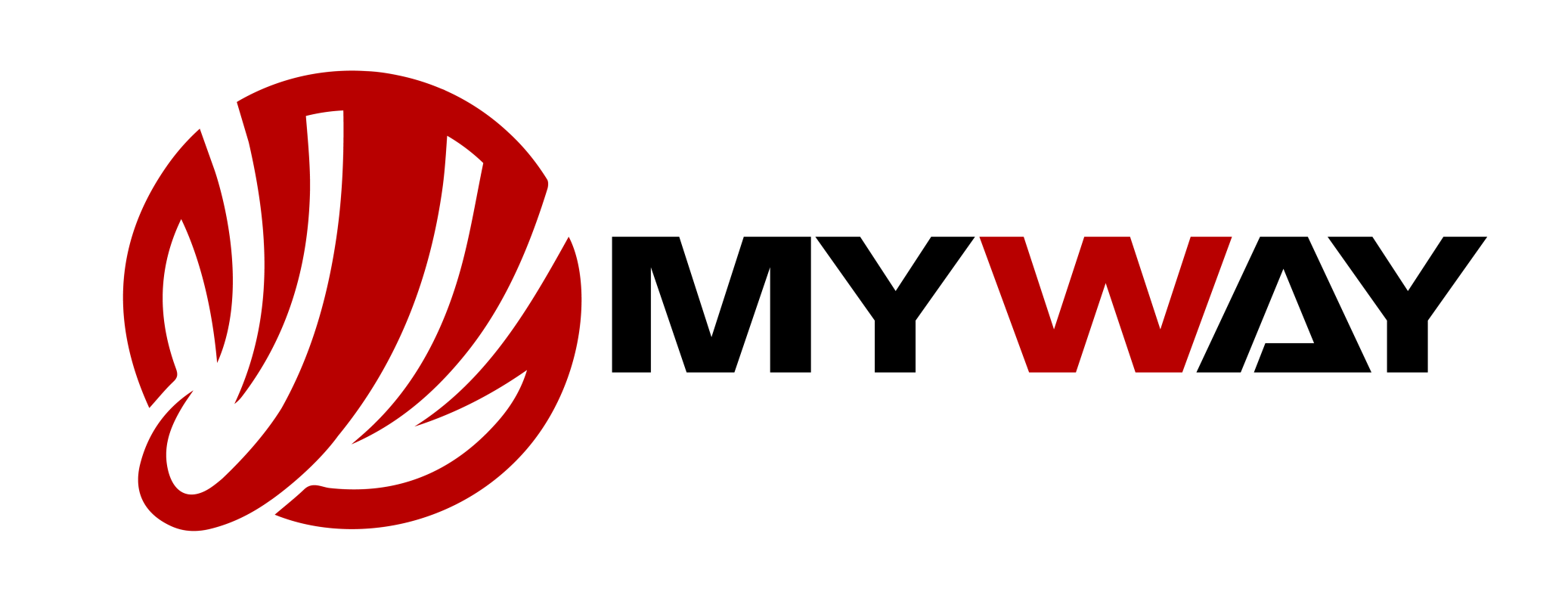Home » How to Replace Bushings on a Car
How to Replace Bushings on a Car?
If your car has abnormal conditions during driving, such as clicking noises when turning or bumping, uneven wear on both sides of the tires, or steering wheel vibrations at high speeds, etc., these are all reminders that the bushings need to be replaced.
Bushings are an indispensable part of the car, especially in the control arms, suspension and chassis. Bushings are wear parts, so regular replacement is necessary for you. In order to save time and reduce costs, you can do it yourself according to this article. Your vehicle performance can also be restored to normal under your operation.
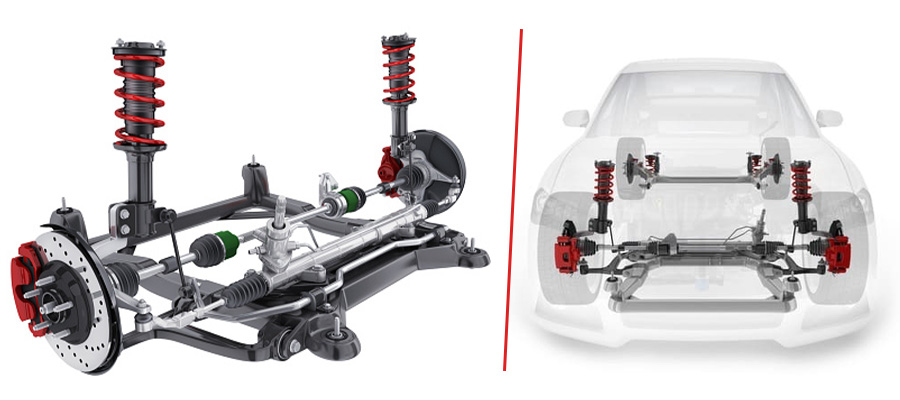
Table of Contents
1. Why is It Important to Replace the Bushing in a Car?
As a consumable part, bushings are often installed inside cars to fix parts and prevent wear. Over time, bushings will wear out, which will have a negative impact on vehicle driving. Therefore, it is necessary to know when bushings need to be replaced. This section will detail the benefits of regularly replacing car bushings and when you should replace them.
1.1 5 Benefits of Changing Car Bushings Regularly
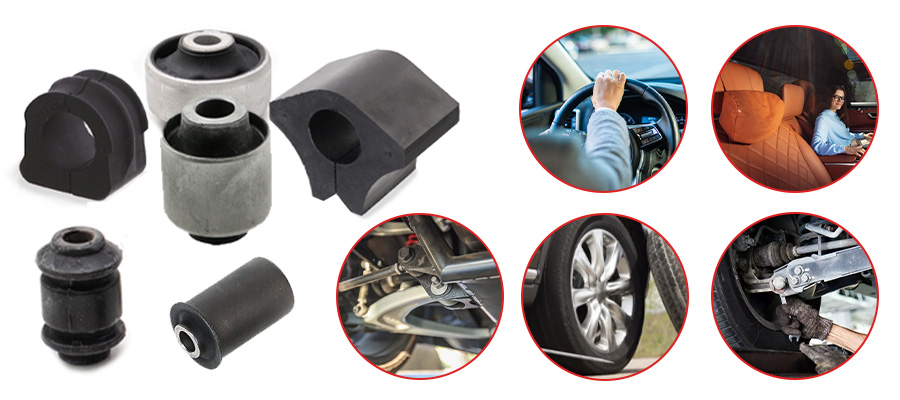
- Improve Driving Stability and Safety
Bushings usually act as buffers between the moving parts of the car’s suspension, steering system and chassis. When they are worn or damaged, they will cause inaccurate steering, vehicle tilt or drift when cornering, and uneven weight distribution when braking or accelerating. Therefore, regular replacement of new bushings can avoid the safety hazards caused by the vehicle.
- Ensure Riding Comfort
Bushings can effectively absorb road vibrations and noise inside the car, but these functions will gradually lose with long-term wear. New bushings can maximize performance and bring a smoother and quieter driving experience.
- Extend theService Life of Components
The most direct function of bushings is to prevent direct contact between metal parts inside the car. When bushings age, adjacent parts will collide or rub, accelerating wear. Replacing new bushings can continue to protect automotive parts and extend their service life.
- Keep Wheels Properly Positioned
Bushings reduce tire wear by properly positioning the wheels. Failure to replace bushings in time will cause tire positioning deviations, “feathering” or excessive wear on the inside and outside. New bushings maintain correct alignment, ensuring even tire wear and extended service life.
- Reduce Maintenance Costs
Ignoring worn bushings can cause other suspension/steering components to overload and wear faster. Regular bushing replacement is a cost-effective preventive maintenance measure to avoid chain damage.
In short, the recommended replacement period for automotive bushings is every 50,000 to 100,000 kilometers. If you replace the bushings correctly and in a timely manner, you can maintain handling performance, comfort and safety while reducing overall maintenance costs.
1.2 5 Signs Your Car Needs Bushing Replacement
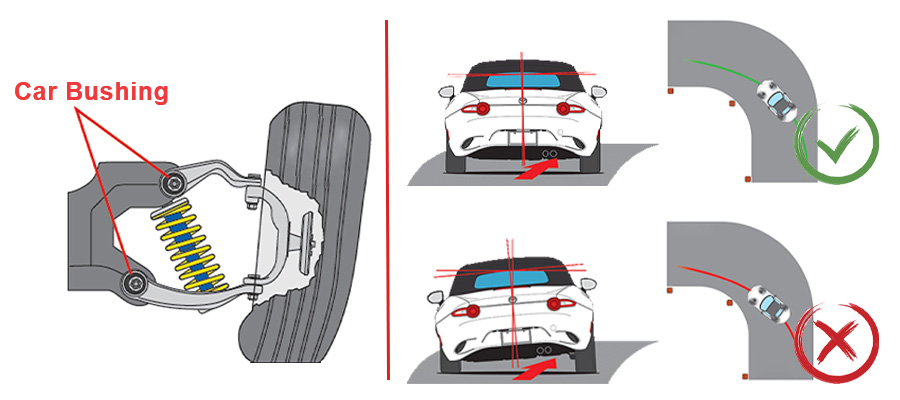
- Metal-on-metal Clunking during Turns or Bumps
There are many kinds of bushings in the suspension or steering system, such as control arm bushings, stabilizer bar bushings, lower arm bushings, etc. When they are worn, broken or fall off, the metal parts that were originally separated will come into direct contact, causing noise when cornering or bumping.
- Steering Wheel Vibration at Highway Speeds
When the car is driving at high speed, the slight shaking of the wheel or the looseness of the steering parts will be transmitted to the steering wheel through the connection mechanism, forming a resonant vibration. This phenomenon indicates that the bushing of the steering system or the front wheel suspension is worn.
- Uneven Tire Wear (Cupping or Scalloping)
Wear of the bushings can cause abnormal shaking or displacement of the suspension components during driving, making it impossible for the wheels to stably adhere to the ground and causing uneven force. This instability can cause repeated excessive impact on parts of the tire, eventually forming periodic “cup-shaped” or “scallop-shaped” wear.
- Loose Steering Feel or Pulling to One Side
If your steering is loose, it is probably because the steering system bushings are worn, the gaps between components are increased, and there is a gap when the steering wheel is turned. Driving deviation is usually caused by uneven suspension system damage and imbalance of suspension support on both sides.
- Visible Cracks/Dry Rot in Rubber Bushings
You can tell the state of the rubber bushing directly from its appearance. When it is exposed to temperature changes, oil erosion, ultraviolet radiation, etc. for a long time, it will gradually harden, lose its elasticity, and then crack, and completely fail, unable to play a buffering and fixing role. You need to replace it immediately.
2. The Essential Tools for Changing Car Bushings?
Although replacing bushings does not necessarily require a professional technician, it is still a complicated job. Before you start, you must first make sure you have enough time and energy and a safe and reliable space. More importantly, you need some tools to assist you in completing the operation and protect you from injury during the process.
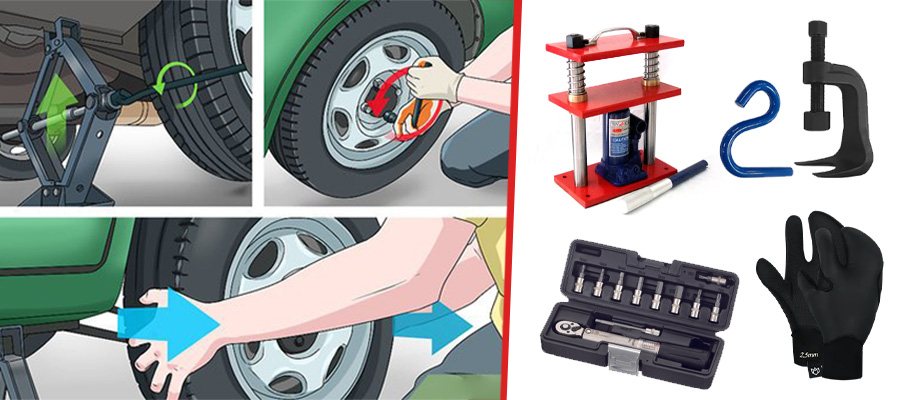
2.1 Hydraulic Press (Recommended for Precision)
If you are replacing high-precision parts such as metal bushings or hydraulic bushings, a hydraulic press is essential. It can achieve non-destructive disassembly and assembly of bushings through uniform high pressure.
It shows the use of hydraulic pressure to push the worn bushing out of the metal part, and then accurately pressurizes to ensure that the new bushing fits the installation hole completely to prevent skewing or loosening.
2.2 Jack Stands, Torque Wrench, Socket Set (14-24mm)
- Jack Stand: You need to use at least two jack nails to replace the temporary support of the jack to prevent the vehicle from falling accidentally. In addition, it needs to be used with tires or bricks as double protection.
- Torque Wrench: Too loose bolts will cause parts to loosen, and too tight may cause metal fatigue or bushing deformation. Using a torque wrench allows you to accurately control the tightening torque of the bolts in strict accordance with the original factory specifications.
- Socket Set: Generally speaking, 14-24mm sockets cover the main bolts of the suspension system, such as shock absorber fixing bolts, control arm ball head nuts, etc., which are suitable for the disassembly and assembly needs of common models.
2.3 Ball Joint Separator, Pry Bar, Penetrating Oil
- Ball Head Separator:Before replacing the bushing, you can use the separator to push open the steering tie rod ball head and steering knuckle to avoid damage to the ball head or bushing due to violent disassembly.
- Pry Bar:The pry bar can assist in prying the suspension components, release the stress at the bushing installation position, and separate the bushing from the installation hole.
- Penetrating Oil:If there are rusted parts, such as bolts, ball heads or bushing interfaces, you can take this opportunity to spray penetrating oil on the surface to penetrate into the metal gaps, soften the oxide layer, and reduce the resistance to disassembly.
2.4 Replacement Bushings (Moog/SuperPro Kits for Most Models)
You need to prepare a new bushing that is completely consistent with the old bushing in advance, which requires you to strictly confirm the specifications and models when purchasing to avoid inconsistent sizes that lead to installation failure.
In addition, if the bushing is not self-lubricating, you need to apply a non-petroleum-based lubricant on its surface in advance, which can reduce the friction coefficient, prevent adhesion with components, and prevent oil from corroding the bushing.
2.5 Safety Gears
- Goggles and Gloves:prevent metal debris and grease from splashing into the eyes, and avoid contact with sharp parts or corrosive liquids.
- Work Lights:illuminate hidden areas of the chassis, especially narrow spaces. Make sure the bushing installation position and bolt hole positions are clearly visible.
3. Detailed Steps to Replace Car bushings
The bushings of car are mainly concentrated in the control arm, stabilizer bar and steering tie rod. The steps for replacing them have a common basic process, but due to the different installation positions, connection structures and effects on suspension geometry, there are differences in details and the operations cannot be completely equivalent. The following is a detailed introduction to the replacement of these three bushings.
3.1 How to Replace Control Arm Bushings?
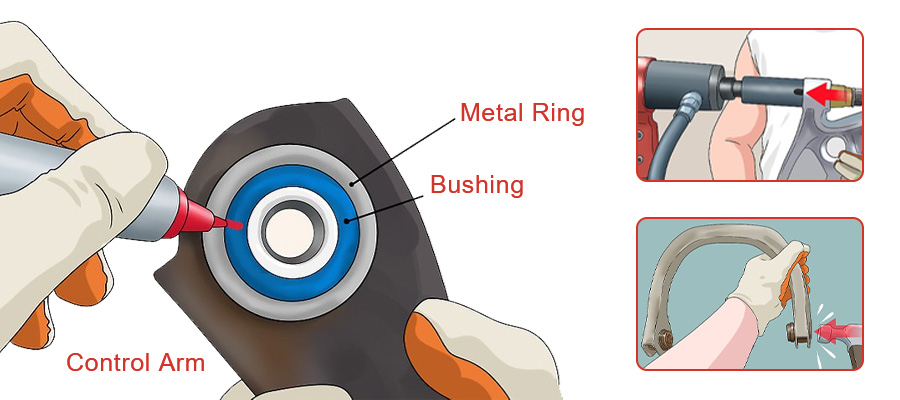
The control arm bushing is a core component of the suspension system. You need to prepare professional tools and operate it carefully and rigorously.
First, support the vehicle with a jack, remove the tire, and expose the control arm. Use a marker to mark the connection position between the control arm and the frame and suspension to facilitate the restoration of the suspension geometry when reinstalling.
Remove the fixing bolts of the control arm and the frame, remove it from the body, and then use a hydraulic press or a special press to press out the old bushings from both ends of the control arm.
Next, use sandpaper to polish the inside of the control arm mounting hole to ensure smoothness and no burrs. Apply a small amount of grease on the surface of the new bushing, align it with the direction of the mounting hole, and use a hydraulic press to slowly press it in until the bushing is flush with the surface of the control arm.
After the new bushing is installed, install the control arm back to the frame according to the original mark, pre-tighten all bolts but do not tighten them completely. Lower the vehicle, let the suspension bear the force naturally, and tighten the control arm bolts again in sequence to the standard torque.
3.2 How to Replace Stabilizer Bar Bushings?
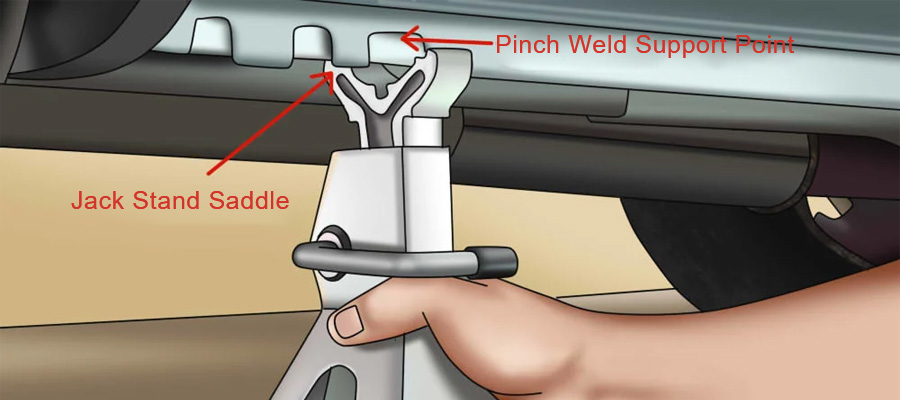
The stabilizer bar bushing is mainly used to reduce the body roll, and its replacement steps are relatively simple.
First, you need to lift the front or rear of the vehicle according to the position of the stabilizer bar, find the bushing bracket connecting the stabilizer bar to the body, remove the bolts or clamps that fix the bracket, and remove the old bushing from the bracket.
Apply silicone grease to the inside of the new bushing, and then insert it into the corresponding position of the stabilizer bar. Reinstall the bushing bracket to the body and tighten the bolts according to the specified torque (usually 30-50 N・m). Finally, put the stabilizer bar link back and check whether the bushing is tightly fitted and not loose.
3.3 How to Replace Steering Tie Rod Bushings?
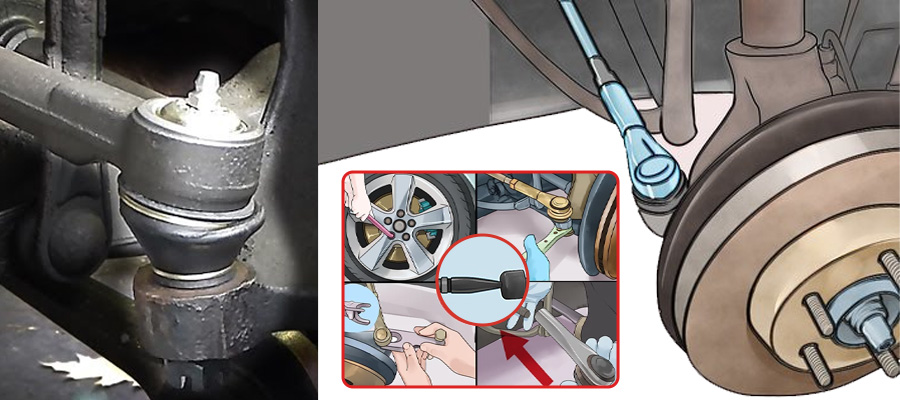
Before replacing the steering bushing tie rod, you need to remove the tire of the car first, find the ball head connecting the steering tie rod and the steering knuckle, and loosen the ball head fixing nut with a wrench. Use a ball head separator to separate the tie rod and the steering knuckle, and pay attention to protecting the ball head dust cover.
Remove the dust cover clamp connecting the steering tie rod and the steering gear, slide the dust cover inward, and remove the old bushing. Apply a small amount of grease on the inside of the new bushing, align it with the mounting hole at the end of the tie rod, and gently knock it into place with a hammer.
Then reset the dust cover and fix it with a new clamp or cable tie. Reconnect the steering tie rod and the steering knuckle, and tighten the ball head nut according to the specified torque.
Finally, put down the vehicle, start the engine, and check whether the steering is light and flexible, without sticking or abnormal noise.
4. Conclusion
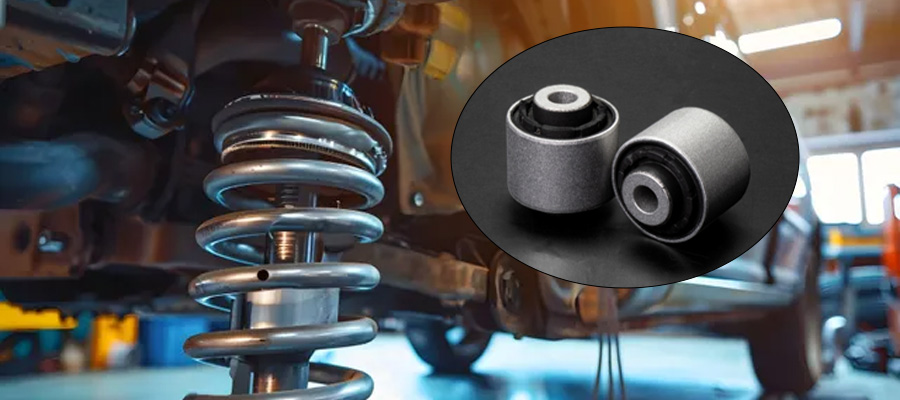
Be well prepared and follow the instructions strictly. I believe you can replace the car bushing perfectly. If you want to know more about bushings, or want to buy some bushings, you can Click Here to contact us. We are a factory that has been focusing on bushing design and production for more than 20 years, aiming to provide you with a one-stop bushing solution!
100000+ Types of Bushings – Contact Us for Details
